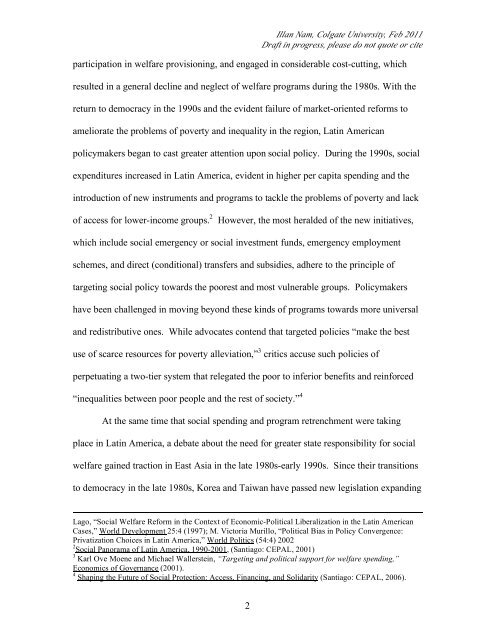Divergent Trajectories: Healthcare Insurance Reforms in East Asia ...
Divergent Trajectories: Healthcare Insurance Reforms in East Asia ...
Divergent Trajectories: Healthcare Insurance Reforms in East Asia ...
You also want an ePaper? Increase the reach of your titles
YUMPU automatically turns print PDFs into web optimized ePapers that Google loves.
Illan Nam, Colgate University, Feb 2011Draft <strong>in</strong> progress, please do not quote or citeparticipation <strong>in</strong> welfare provision<strong>in</strong>g, and engaged <strong>in</strong> considerable cost-cutt<strong>in</strong>g, whichresulted <strong>in</strong> a general decl<strong>in</strong>e and neglect of welfare programs dur<strong>in</strong>g the 1980s. With thereturn to democracy <strong>in</strong> the 1990s and the evident failure of market-oriented reforms toameliorate the problems of poverty and <strong>in</strong>equality <strong>in</strong> the region, Lat<strong>in</strong> Americanpolicymakers began to cast greater attention upon social policy. Dur<strong>in</strong>g the 1990s, socialexpenditures <strong>in</strong>creased <strong>in</strong> Lat<strong>in</strong> America, evident <strong>in</strong> higher per capita spend<strong>in</strong>g and the<strong>in</strong>troduction of new <strong>in</strong>struments and programs to tackle the problems of poverty and lackof access for lower-<strong>in</strong>come groups. 2However, the most heralded of the new <strong>in</strong>itiatives,which <strong>in</strong>clude social emergency or social <strong>in</strong>vestment funds, emergency employmentschemes, and direct (conditional) transfers and subsidies, adhere to the pr<strong>in</strong>ciple oftarget<strong>in</strong>g social policy towards the poorest and most vulnerable groups. Policymakershave been challenged <strong>in</strong> mov<strong>in</strong>g beyond these k<strong>in</strong>ds of programs towards more universaland redistributive ones. While advocates contend that targeted policies “make the bestuse of scarce resources for poverty alleviation,” 3 critics accuse such policies ofperpetuat<strong>in</strong>g a two-tier system that relegated the poor to <strong>in</strong>ferior benefits and re<strong>in</strong>forced“<strong>in</strong>equalities between poor people and the rest of society.” 4At the same time that social spend<strong>in</strong>g and program retrenchment were tak<strong>in</strong>gplace <strong>in</strong> Lat<strong>in</strong> America, a debate about the need for greater state responsibility for socialwelfare ga<strong>in</strong>ed traction <strong>in</strong> <strong>East</strong> <strong>Asia</strong> <strong>in</strong> the late 1980s-early 1990s. S<strong>in</strong>ce their transitionsto democracy <strong>in</strong> the late 1980s, Korea and Taiwan have passed new legislation expand<strong>in</strong>gLago, “Social Welfare Reform <strong>in</strong> the Context of Economic-Political Liberalization <strong>in</strong> the Lat<strong>in</strong> AmericanCases,” World Development 25:4 (1997); M. Victoria Murillo, “Political Bias <strong>in</strong> Policy Convergence:Privatization Choices <strong>in</strong> Lat<strong>in</strong> America,” World Politics (54:4) 20022 Social Panorama of Lat<strong>in</strong> America, 1990-2001, (Santiago: CEPAL, 2001)3 Karl Ove Moene and Michael Wallerste<strong>in</strong>, “Target<strong>in</strong>g and political support for welfare spend<strong>in</strong>g,”Economics of Governance (2001).4 Shap<strong>in</strong>g the Future of Social Protection: Access, F<strong>in</strong>anc<strong>in</strong>g, and Solidarity (Santiago: CEPAL, 2006).2













